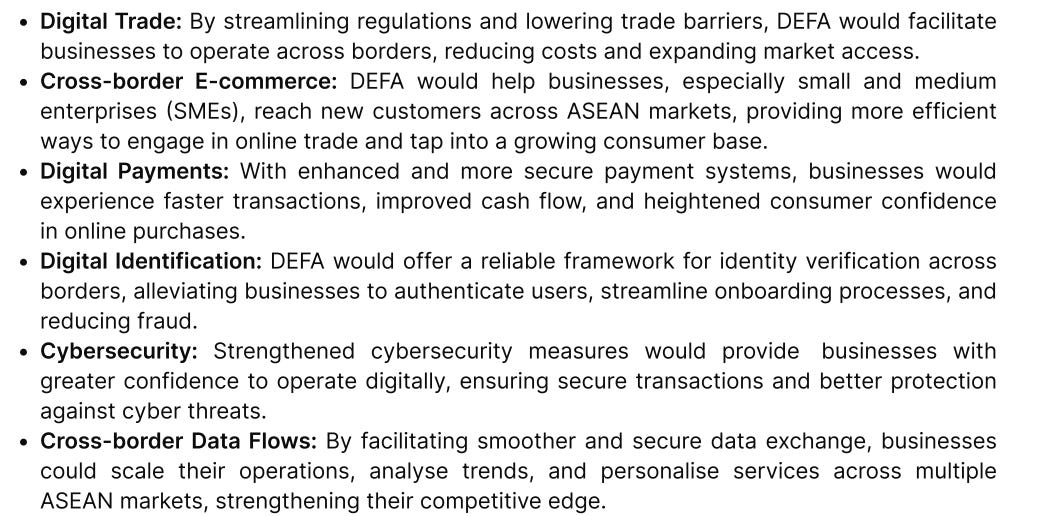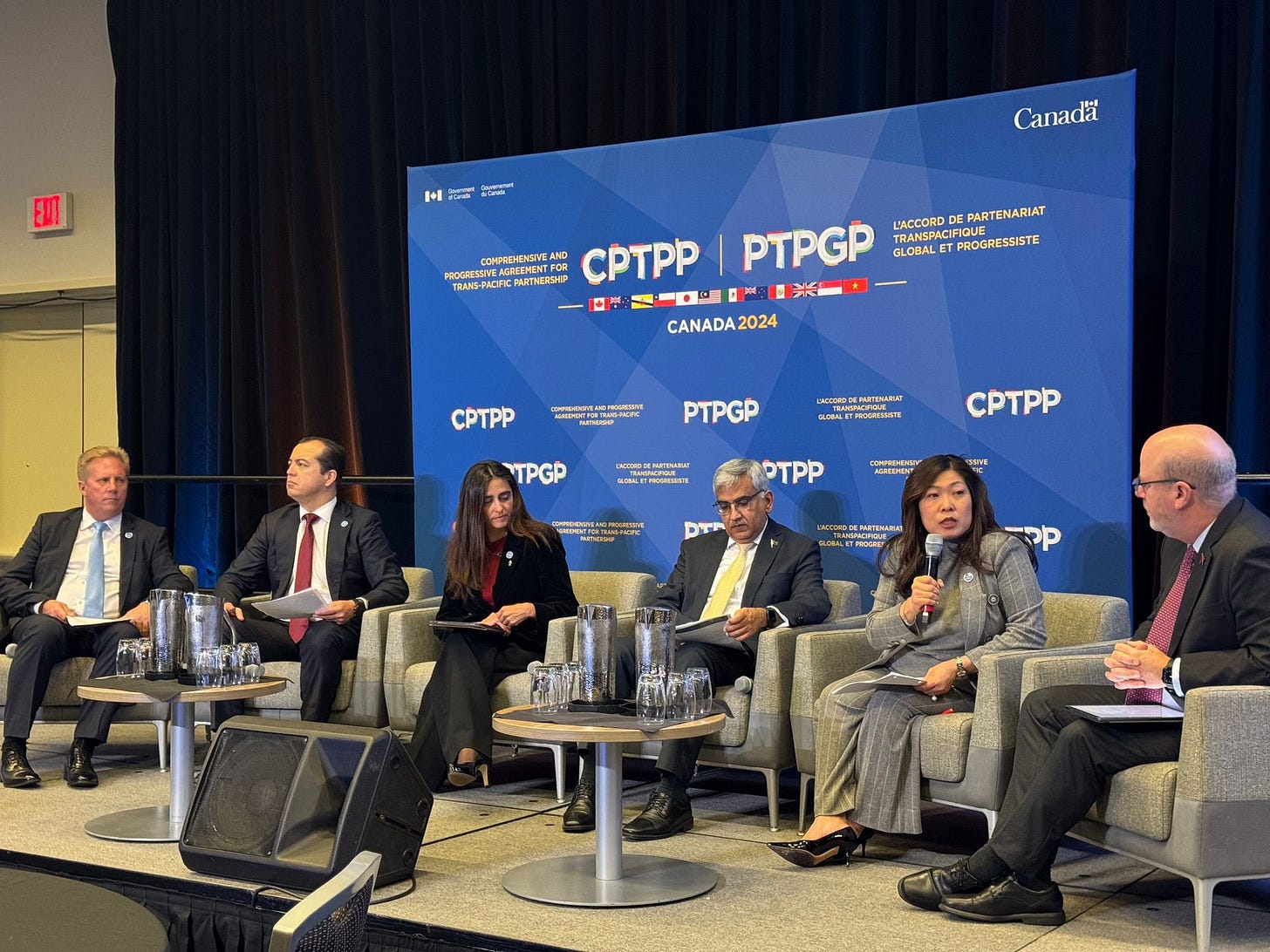New CPTPP Membership Talk Headlines Indo-Pacific Geoeconomic Meet
Plus coming trilateral first; global derisking landscape; 2025 trade pact chatter; new high-speed inroads; growing semiconductor partnership and much, much more.
Greetings to new readers and welcome all to the latest edition of the weekly ASEAN Wonk BulletBrief! If you haven’t already, you can upgrade to a paid subscription for $5 a month/$50 a year below to receive full posts by inserting your email address and then selecting an annual or monthly option. You can visit this page for more on pricing for institutions, groups as well as discounts. For current paid subscribers, please make sure you’re hitting the “view entire message” prompt if it comes up at the end of a post to see the full version.
For this iteration of ASEAN Wonk BulletBrief, we are looking at:
Assessing the geopolitical and geoeconomic significance of new membership talk amid a key Indo-Pacific geoeconomic meet;
Mapping of regional developments, such as a coming trilateral first; Mekong partnership talk and a cross-regional upgrade;
Charting evolving geopolitical, geoeconomic and security trends such as a coming trade pact; new cross-continental sectoral agreement and growing semiconductor partnership;
Tracking and analysis of industry developments and quantitative indicators including infrastructure funding uncertainties; shifting supply chain negotiations; evolving high-speed inroads and more;
And much more! ICYMI, check out our new ASEAN Wonk Podcast episode with an ex high-ranking diplomat on the future of Malaysia’s foreign policy under Anwar Ibrahim, including on the Global South and Middle East conflict.
This Week’s WonkCount: 2,178 words (~10 minutes)
Coming Trilateral First; New Mekong Partnership Talk; Cross-Regional Upgrade & More

Shifting Global Derisking Landscape; Digital Trajectory & Rebel Futures
“[D]erisking is not a unilateral option but rather an interactive and fluid development taking place around the globe,” with the U.S. and its allies pursuing reshoring, nearshoring and friendshoring and China seeking diversification into markets like the Global South and Russia, warns a new publication in Asia Policy on shifting Indo-Pacific trade and supply chains. The article aims to look beyond material flows and assess shifting patterns across non-material domains including information, financial and human flows (link).
“As ASEAN gazes towards the future, the ASEAN Community Vision 2045 sets the stage for a connected digital community,” notes a commentary by the ASEAN Deputy Secretary-General in a series published by CSIS Jakarta. The commentary delves into opportunities that a Digital Economic Framework Agreement could have across areas like cybersecurity and digital trade (link).
Key Digital Domain Areas Affected by Evolving ASEAN Regional Trends and Developments
“Despite the Philippine military’s undeniable gains, force alone would not completely squash the Maoist insurgency,” argues a new article on the persistent communist rebellion in the Philippines over half a century since it first kicked off published by the International Crisis Group. The article suggests that the government has much work to do in addressing longstanding inequities that have plagued the Philippines (link).
New CPTPP Membership Talk Amid Indo-Pacific Geoeconomic Meet
What’s Behind It
Members of a key Indo-Pacific trade pact met and discussed key issues including expanding membership and initiatives1. After adding the United Kingdom, the original members of the Comprehensive and Progressive Agreement for Trans-Pacific Partnership (CPTPP) — which comprise about an eighth of global GDP and feature four ASEAN states in Brunei, Malaysia, Singapore and Vietnam — are now examining how to proceed with a growing series of new cross-continental accession requests spanning from Costa Rica to China2. ASEAN Wonk also understands discussions have increasingly centered on how to approach sectoral issues in 2025 amid divisions between members. This reflects the reality that dynamics and agenda items have expanded far beyond the issue of U.S. withdrawal from the original TPP back in 2017 under U.S. President Donald Trump’s first term3. Some of these datapoints were in the spotlight during a flurry of summit meetings in November. These included the G-20, APEC and COP29 climate talks (see ASEAN Wonk snapshot below).
Recent Geoconomic and Geopolitical Developments and Southeast Asia Stakes Amid CPTPP Meet
The CPTPP meeting captured the mixed economic picture for Southeast Asia and Indo-Pacific states heading into 2025. On the one hand, developments over just the past few weeks have reinforced the reality that the Indo-Pacific — including key Southeast Asian states — is set to remain at the heart of global geoeconomic conversations. To take just a couple of examples, Singapore agreed to set up a new green minilateral with like-minded partners; Vietnam finalized its 2027 hosting of APEC and Indonesia saw an update in its ongoing bid for membership in a key economic grouping4. On the other hand, officials remain conscious of headwinds heading into 2025. Beyond future policies undertaken by U.S. president-elect Donald Trump, these include the effects of broader trends and developments including fragmentation, coercion and market distortion5.
Why It Matters
The CPTPP meeting also provided a window into key datapoints to watch in the Indo-Pacific trade space in 2025 and beyond along with the implications for Southeast Asian states as well as the region (see originally generated ASEAN Wonk table below on notable developments on areas to watch, select major datapoints and key domains. Paying subscribers can also read on for more on what to expect and future implications in the rest of the “Why It Matters” and “Where It’s Headed” sections, along with remaining paid-only sections of the newsletter as usual)6.











